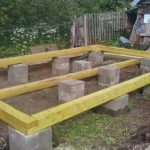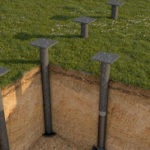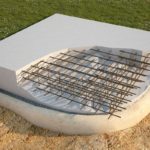In private construction, housing built from natural materials is becoming increasingly popular. Wood has a lot of positive characteristics in terms of health and comfort. In order for the final result to comply with all construction and sanitary parameters, it is necessary to correctly and competently choose the foundation for the log house. Modern technologies provide private developers with a wide range of solutions, each of which has its own characteristics, pros and cons.
Features of timber as a building material
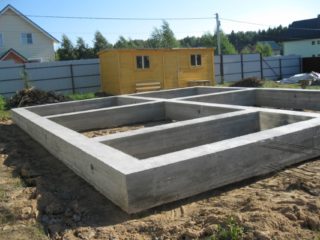
Wood has a history of many thousands of use as a material for the construction of residential and auxiliary structures. During this time, mankind has accumulated a huge amount of knowledge on the storage, processing of this unique raw material, and the operation of structures made from it.
When choosing a foundation for a house from a bar, it is necessary to take into account the following properties of wood:
- Relatively low specific gravity. Even a thick wall does not exert significant pressure on the substrate. There is no need to build a powerful support system, unless it is a multi-storey building full of household appliances.
- Porosity and hygroscopicity. Wood with high humidity absorbs water and becomes 1.5-2 times heavier. This excludes the possibility of manufacturing a light foundation for a beam, designed for minimum values.
- Flexibility. Without a stop along the entire length, the crowns bend, which leads to deformation of the walls and floors. A rigid and static base is required.
- Rotting tendency. Under the influence of dampness, the wood begins to decompose, gradually turning into dust. It is required to raise it a considerable distance from the ground, paying due attention to waterproofing.
Means have been developed that increase the resistance of wood to moisture, fire, insects and microorganisms. Correct and timely processing of the material will extend its service life up to 70-100 years.
Factors for choosing the type of foundation
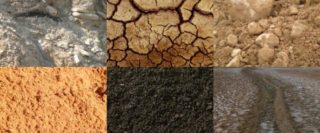
Choosing a strip foundation for a log house, it is necessary to approach the decision correctly, with an assessment of all the conditions that accompany construction. Even a small oversight can negatively affect the building in the not too distant future.
Consideration should be given to the following circumstances:
- Soil type. This indicator determines its stability, bearing capacity and the degree of increase in volume (heaving) when freezing.
- The depth of soil freezing in the cold season. This factor determines the level of the lower part of the foundation relative to the surface.
- Estimated mass of a building (walls, floors, roof) with people inside it, furniture and household appliances.
- Terrain relief. The difference in heights along the perimeter of the future building, the need for volume, feasibility and cost of earthworks are taken into account.
- Groundwater level. The issue of waterproofing, drainage system, the depth of lowering the base and the material of its manufacture are being resolved.
All data is analyzed, summarized, compared, after which a decision is made on the type and design of the support system.
Study of soil properties
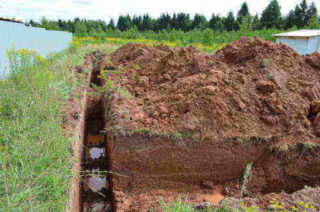
Lateral and vertical loads, which affect the underground part of the building, depend on the properties of the soil on the site. The amount of pressure applied depends on the amount of water that is trapped in the ground. The more it is, the stronger the level of expansion during freezing, the pressure exerted on the structure.
Features of different types of soil:
- Clayey. The most difficult and unsuccessful option for construction. It absorbs moisture well, turning into a slurry with its excess. After drying, it shrinks and cracks. When the clay freezes, it swells, which can destroy the support system or push it to the surface.
- Loamy. Contains up to a third of clay, which is due to less heaving and greater bearing capacity. The deep foundation of the house is recommended.
- Sandy loam. Has a mixed composition of organic matter, sand and a tenth of clay. Differs in good stability, low water absorption and almost complete absence of heaving.
- Sandy. Sand does not absorb or retain water, and in a compacted state it is an excellent basis for the construction of any type of foundation.
After determining the type of soil, it is necessary to clarify its bearing capacity. It can be found in SNIP, which describes in detail the recommendations for conducting construction in all types of terrain.
Types of foundations for a house from a bar
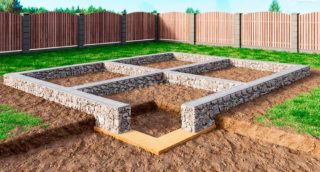
There are several support systems that are fundamentally different in design:
- Tape. It is a closed loop in the form of a vertically located strip of reinforced concrete. According to the assembly options, it can be monolithic and prefabricated. In the first case, a formwork is made, into which concrete is poured after laying the steel frame. When performing construction in the second way, reinforced concrete blocks (FBS) are placed in the trench and fixed. You can choose a tape that, depending on the characteristics of the soil, deepens below the freezing level by 30-50% of this value or fits on the surface. The advantage of the recessed type is the possibility of arranging a basement or an elevated basement. The belt support system is considered universal and is excellent for almost all construction conditions.
- Columnar. It is the simplest and most inexpensive option for arranging the base for light wooden structures. Supports can be made of rubble, brick, reinforced concrete blocks and wood. At the same time, the foundation from a bar must be carefully processed from dampness and parasites. Supports are placed at a distance of up to 200 cm around the perimeter of the building, under internal walls and at points with increased stress. Typically, the laying depth does not exceed 50 cm with additional filling of a sand cushion or pouring a concrete base. The calculation of the number of posts is done based on the analysis of the weight of the house and the bearing capacity of the soil.
- Screw. The piles are hollow steel pipes with a pointed tip. The product is equipped with blades, due to which they can be screwed into the ground and held in it at any temperature and humidity. After screwing in the piles, their heads are aligned horizontally and concrete mortar is poured into the pipes. The standard length of the products is 165 and 330 cm, which is quite enough for dropping below the freezing level. The advantages of a screw foundation are a stable position in the ground and the possibility of mounting on rough terrain.
- Plate. Monolithic foundations are used in construction on unstable soils or for the construction of structures where there is no need to make a basement and lay underground communications. The slab technology is quite simple, but it requires a lot of materials. After fragments of the pit, waterproofing, insulation, a pillow and a reinforcing cage are placed in it. Then concrete is poured.The finished slab is at the same time a subfloor, which becomes a big plus for the developer. The disadvantage of this solution is that the foundation has a slight elevation above the ground, which requires the arrangement of the basement or additional finishing of the lower rims of the masonry. Otherwise, the log house will constantly get damp and moldy.
In all cases, it is necessary to strictly follow the instructions for the rules for making the support system, since every little thing matters.
The technology of laying the first row of beams on the foundation
The quality of the final result of removing the walls largely depends on the correct laying of the first row of timber. Initially, you need to make the right choice regarding the type of wood, which will take on the maximum pressure and exposure to dampness. It is advisable not to spare money and purchase the right amount of durable and sustainable material. It can be cedar, larch or oak. Better yet, make 2-3 lower levels from these types of wood.
On the slab, pillars and tape, the timber is laid with holes on pre-embedded mortgages in the form of pins. If a pile foundation is installed, plates are welded to the heads of the products, and the lower rims are bolted to them.
In all cases, a waterproofing layer is placed between the wood and the foundation.

